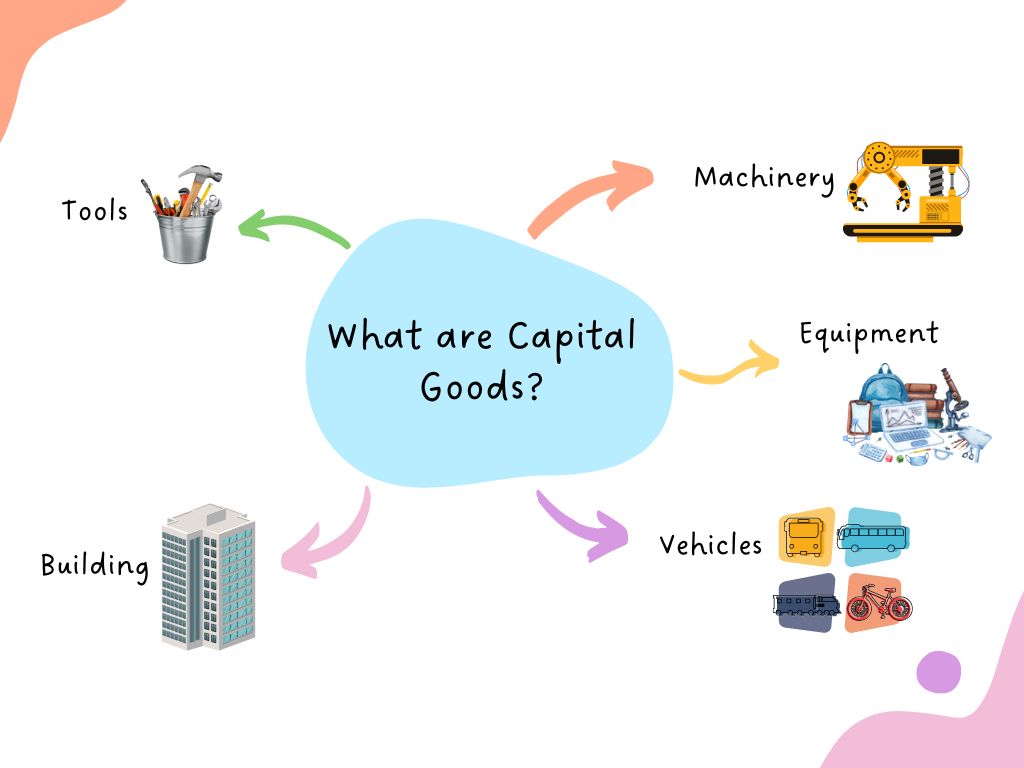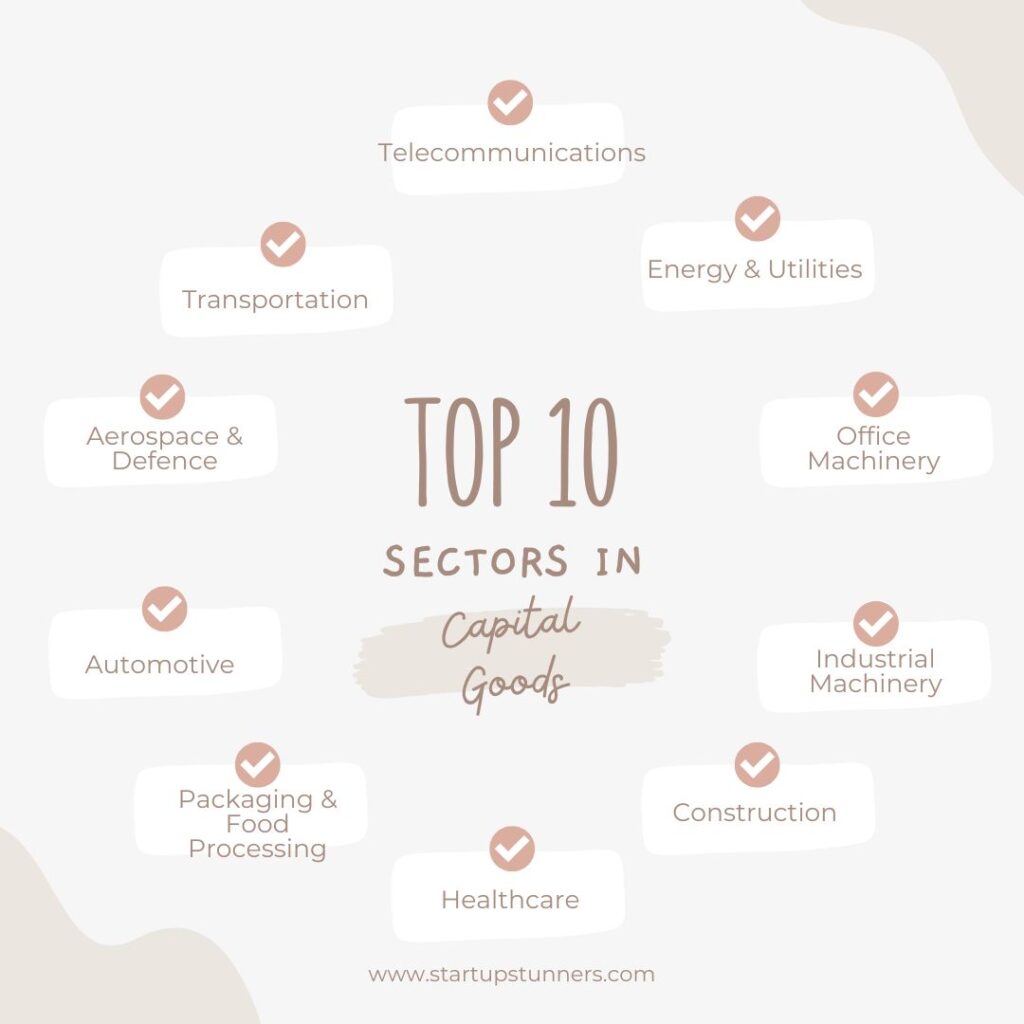The capital goods industry is a critical component of the global economy. It provides raw materials to manufacturers, industrial equipment, and business facilities.
The capital goods sector is an ever-expanding market for goods and services that help businesses grow and prosper. This industry’s businesses produce everything from automobiles to paper clips. Capital goods companies offer excellent advancement opportunities and stable pay, so they should be on your list of potential employers.
In other words, it provides the infrastructure required for any modern economy. The capital goods sector contains a wide range of businesses. Companies in this market include those whose primary focus is construction machinery and those whose primary goal is to provide office equipment and other goods and services.
The availability of capital commodities is critical to the efficient operation of an economy. They contribute to the production of goods and services that benefit everyone. It’s difficult to imagine how different our lives would be without them.
What Are Capital Goods?

The term “capital goods” refers to any physical assets that a business uses during production to provide consumer goods and services. This process benefits consumers because it leads to the development of the products and services they purchase. Capital goods manufacturers can be found in a variety of industries. Among the most common types of businesses are manufacturers of industrial machinery, tools, and transportation vehicles. These businesses produce the goods that keep other commercial and industrial establishments running smoothly.
The global capital goods market is estimated to be worth more than $12 trillion. The United States is a major destination for industrial supplies in terms of purchasing power. The demand for new machinery or other expensive items rises and falls in tandem with the economy. When a business is doing well, it can afford to invest in things like new machinery and office space.
When the economy slumps, however, businesses drastically reduce their capital expenditures, resulting in a sharp drop in demand for capital goods. As a result, industries producing capital goods may be forced to reduce their workforce and close their operations. Despite current challenges, the capital goods sector is critical to global trade and economic growth.
Types Of Capital Goods Companies
Production of capital goods occurs across many different industries. The different types include
- Material handling equipment manufacturers
- Mining equipment manufacturers
- Oil and gas field machinery manufacturers
- Machinery manufacturers
- Construction equipment manufacturers
- Railroad car manufacturers
- Shipbuilders
- Equipment manufacturers
What Comes Under Capital Goods Industry?
Here are the top 10 sectors in the capital goods market:

- Telecommunications
- Energy and utilities
- Office machinery
- Industrial machinery
- Construction
- Health care
- Packaging and food processing
- Automotive
- Aerospace and Defense
- Transportation
What Companies Are In The Capital Goods Field?
1. Lockheed Martin
Company Size: 10,000+ employees
In 1995, a company Lockheed Martin with interests in the aviation and military sectors was founded. The development of military weapons, such as semiautomatic rifles, fire detectors, aircraft rockets, and a variety of others, is one of the company’s core competencies. The company is frequently ranked among the world’s most influential businesses as a leader in aircraft, military assistance, security, and technology.
The United States government, specifically the Department of Defense and other federal entities, is the firm’s primary client base. Lockheed Martin is made up of four distinct business units that all operate independently of one another. These are the departments:
- Missiles And Fire Control
- Space
- Aeronautics
- Rotary And Mission Systems
The annual revenue for the corporation is about $65 billion.
Employee Benefits:
- Retirement plans
- Paid time off days
- Relocation assistance
- Health insurance
- Dental Insurance
- Tuition reimbursement
- Flexible schedule
2. Caterpillar Inc.
Company Size: 10,000+ employees
Caterpillar Inc., more commonly known simply as Caterpillar or CAT, has been a construction-focused company since its founding in 1925. In terms of product development and manufacturing, the company focuses on construction and mining equipment such as diesel-electric locomotives, gas-powered generator sets, and auxiliary power units. CAT operates in over 180 countries and has locations on every continent. Taken as a whole, these locations can be found all over the world.
It has a yearly revenue of more than $40 billion and provides products and services to three major industries: construction, mining, and energy and transportation. It also provides hydraulics, paving, and drilling tools and equipment.
Employee Benefits:
- Medical coverage
- Vision insurance
- Vacation days with salary
- Support for Relocation
- Dental Insurance
- Provisions for Old Age
3. General Electric
Company Size: 10,000+ employees
General Electric, or “GE,” was founded in 1892 and has been in the manufacturing industry ever since. General Electric (GE) is a multinational conglomerate with operations in a variety of industries, including transportation, power generation, renewable energy, and healthcare. Boston and New York serve as its headquarters.
As a result, the company produces a wide range of products, including weapons, aero engines, computer programmes, energy sources (such as wind turbines), electric motors, and other items. General Electric’s annual sales of more than $10 billion are what keep the company afloat.
Employee Benefits:
- Coverage for medical expenses
- Paid vacation days
- Workplace flexibility
- Dental Insurance
- Reward for Signing On
- Insurance for the disabled
- Eye protection plans
4. Union Pacific
Company Size: 10,000+ employees
A share of Union Pacific stock is currently available for $221, representing an 11% year-to-date decline. That is significantly less than the S&P 500, which has lost approximately 14% in the same time frame. Despite the fact that the railroad industry’s fortunes rise and fall in lockstep with the economy, rising interest rates and recessionary concerns are dampening business. As a result, a number of well-known Wall Street analysts have downgraded the stock.
Simply put, a capital goods sector firm manufactures the tools and supplies on which other industries rely. The automotive industry, for example, would be unable to function without inputs from the capital goods sector. These businesses’ output is critical to the economy as a whole because the products they produce enable other businesses to operate more effectively and efficiently. There are numerous companies in this industry, and Union Pacific is just one of them.
Union Pacific is a capital goods company that manufactures coal, agricultural commodities, and automobiles. It also maintains ties with train systems in Mexico and Canada. Despite the cyclical nature of the economy, Union Pacific’s capital expenditure is higher than the industry average. However, there are additional benefits available to employees at this organisation, such as paid time off and school tuition reimbursement.
Union Pacific’s coal business is picking up steam, despite its lower volume before the epidemic, due to rising household output and, as natural gas prices rise around the world, rising global demand. Coal and energy revenue increased by 49% in 2017 as a result of increased volume and decreased operating income per carload. This pattern of growth is consistent with the company’s main business plan, which has successfully attracted a large number of new applicants each year.
Union Pacific’s value is primarily determined by the market’s expectations of its long-term capital costs. This forecast takes into account the most significant risk that the organisation will face in the coming years. This means that at a 9.5 percent discount rate, the equity per share of stock is $82. Furthermore, the corporation’s unfunded pension liabilities are factored into this value. The company’s operating profits have increased over the last year from a previous high of around 37.9%. Despite the fact that Union Pacific’s profit has been increasing in recent years, it is highly unlikely that it will reach 44% before the economy collapses.
Employee Benefits:
- Finances for Old Age
- Optical coverage
- Cash grants for education
- Paid time off
- Coverage for medical expenses
- Dental Health Insurance
5. Northrop Grumman
Company Size: 90,000 employees
Northrop Grumman was already well known as a leading aerospace and defence contractor when it was founded in 1939. The primary industrial assets of the company are in the development of land and space defence tools and supplies, such as aeroplanes, flying vehicles, chain weapons, autocannons, ammunition, spacecraft, missile launch systems, stealth bombers, communications devices, and others.
Northrop Grumman is a multinational corporation that operates in a variety of markets, including those related to aeronautics, military, intelligence, space, and other disciplines. The corporation has numerous headquarters spread across the United States. Long-term plans for the company include the development of cutting-edge new defence goods as well as the maintenance and enhancement of existing offerings.
Northrop Grumman’s annual revenue is nearly $30 billion.
Employee Benefits:
- Promotional Offers for Staff
- Financial aid for higher education
- Retirement funds
- Coverage for medical costs
- Paid holidays
6. ABB Limited
Company Size: 5,001 to 10,000 employees
ABB Limited, or simply ABB, is a company that has been active in the energy, minerals, and utilities sectors since 1898. The primary focus of the company is the production of control products, cable networks, circuit breakers, buttons, and other types of electronic equipment. The company also provides setup and maintenance services for its customers’ systems.
Although the company has its roots in North Carolina, the United States remains its most important market. This company’s annual revenue exceeds $26 million.
Employee Benefits:
- Medical coverage
- Pensions
- Disability Insurance
- Life insurance
- Optical coverage
- Paid Leave days
7. Honeywell International
Company Size: 10,000+ employees
Honeywell International, or simply Honeywell, is a company that has been in operation since its inception in 1885. This company’s many products include those tailored to the needs of the aviation, automobile, petrochemical, and industrial automation sectors.
Honeywell is well-known for producing a wide range of products, including but not limited to automobile parts, specialty chemicals, polymers, engineered components, and other items. The company makes more than $32 million in profit per year.
Employee Benefits:
- Medical coverage
- Pensions
- Childcare Leaves
- Life insurance
- Paid vacation days
- Bonus for joining the team
8. 3M
Company Size: 93,000+ employees
The Minnesota Mining and Manufacturing Company (3M) was founded in 1902 and is a Fortune 500 company known for developing innovative products. This multinational corporation, headquartered in Minnesota, manufactures a wide range of materials, including glue, composite materials, cutting tools, window films, paint protection films, and much more. To date, the company offers over 60,000 products and services for sale.
Under various brand names, it also manufactures dental and orthodontic supplies, pharmaceuticals, vehicle parts, electronic gadgets, and healthcare IT. Through its network of offices, 3M has a presence in over 87 countries worldwide.
Employee Benefits:
- Medical coverage
- Retirement plans
- Insurance for Teeth
- Vision protection policies
- A Chance to Invest in Stocks
- Days off for vacation
9. Boeing
Company Size: 10,000+ employees
Boeing, founded in 1916, is a multinational corporation with deep roots in the aviation and military industries. This multinational conglomerate is the industry leader in all aerospace-related sectors, with three main divisions: army, space, and protection; commercial aircraft and global services; and space research and safety.
In addition, Boeing assists airlines and government customers in over 150 countries that support the United States. Over the course of a year, the company earns more than $58 million in revenue from the sale of military and commercial aircraft, space satellites, electromagnetic missile batteries, rocket boosters, weapons, and other items.
Employee Benefits:
- Help with Relocation
- Help with Relocation
- Dental Health Plans
- Allowance for Parental Leave
- Safety-net vision care
- Days off work with pay
- Treatment coverage
- Insurance for the disabled
Conclusion
Those with an urge to innovate and build things might look into careers in the manufacturing of capital goods. It’s also an excellent for anybody hoping to become a supplier in the ever-growing network that drives the international economy. You can make a difference and a solid living by working in the capital goods industry.
Frequently Asked Questions
Is Capital Goods A Good Career Path?
Yes, the capital goods industry is an intriguing business that may be a good fit for young professionals who want to improve their skills and knowledge while still earning a living wage. If you want to work in the capital goods industry and earn a lot of money, you have a lot of options.
What Are 5 Capital Goods Examples?
Capital goods are long-lasting commodities produced by human industry and used by commercial enterprises to produce other products and services. For example,
Tools & Machinery
Computers
Construction equipment
Buildings
Vehicles
Are Raw Materials Capital Goods?
No, these are two separate types of goods. Capital goods must be manufactured items that directly contribute to the production of other commodities or services. Minerals and other raw materials are not considered capital goods in and of themselves, but are used in the production of capital and consumer goods.
Why Are Capital Goods Important In Economics?
Investment in new machinery and equipment frequently predicts economic growth. The purchase of new capital goods is frequently a reliable indicator of economic expansion.
How Many Jobs Are Available In Capital Goods?
Because of its importance in the labour market, the manufacturing industry is a pillar of economic growth. This is why the industrial sector employs so many people.
People who work with capital goods are employed in construction, mining, engineering, and other related fields. They are also widely used in public institutions and organisations such as utilities and transportation, as well as at the state and federal levels of government.
What Do Capital Goods Jobs Pay?
According to the Bureau of Labor Statistics, salaries for positions related to capital goods are above average. Capital goods are long-lasting and high-quality items that are produced or used over time rather than immediately.
Computers, electronics, and building construction machines are among these items. The Bureau of Labor Statistics forecasts an 8% increase in overall employment between July 2017 and 2021, with the capital goods sector expected to grow at an 18% rate.
What Are The Best Paying Jobs In Capital Goods?
Businesses require capital goods in order to create more products. Simply put, they are used as inputs in a variety of industries.
According to Salary.com, the following ten positions are the highest paid in the capital goods industry:
Engineers in computer hardware ($110,000)
Engineers in electrical engineering ($100,900)
Engineers in mechanical engineering ($98,647)
Engineers in the aerospace industry ($92,500)
Geologists and environmental scientists ($90,000)
($90,800) Chemical Engineers
Mathematicians and computer scientists ($100,000)
Managers of construction ($98,000)
Software developers (annual salary average of $115,998)
IT and telecommunications professionals ($107,950)






